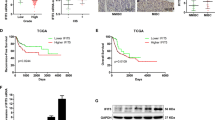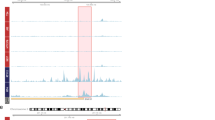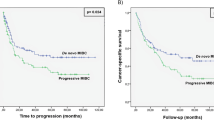Abstract
Urothelial carcinoma is the most common type of bladder cancer and can be categorized as either non-muscle-invasive (Ta-T1) or muscle-invasive (⩾T2). The majority of bladder cancers are non-muscle-invasive at presentation; however, the recurrence rate for these tumors is high and a subset can progress to T2. In this study, we aimed to identify genes differentially expressed between T1 vs T2 bladder cancer to identify key regulators of bladder cancer progression and/or invasion. We performed RNA-Seq on T1 and T2 bladder cancer tissues and used publicly available bladder cancer profiling studies to prioritize differentially expressed genes for validation and functional assessment. This integrative approach nominated an extracellular matrix glycoprotein, fibulin-3 (FBLN3, also known as EFEMP1), as being highly expressed in T2 vs T1 bladder cancer and aggressive vs indolent disease. We confirmed the overexpression of fibulin-3 in ⩾T2 vs non-muscle-invasive bladder cancer (NMIBC) by quantitative reverse transcriptase–PCR. Consistent with these findings, fibulin-3 expression level correlated with the invasive ability of several bladder cancer cell lines and modulation of fibulin-3 expression directly affected invasion. Fibulin-3 knockdown in bladder cancer cells decreased the incidence of MIBCs in a murine orthotopic bladder cancer model and decreased the expression of insulin-like growth factor-binding protein-5 (IGFBP5). Restoring IGFBP5 in these cells rescued their invasive and migratory potential. These results indicate that fibulin-3 serves as a pro-invasive factor in bladder cancer, which may be mediated through modulation of IGFBP5 expression. This also suggests fibulin-3 and IGFBP5 may have potential as biomarkers of aggressive bladder cancer or therapeutic targets.
This is a preview of subscription content, access via your institution
Access options
Subscribe to this journal
Receive 50 print issues and online access
$259.00 per year
only $5.18 per issue
Buy this article
- Purchase on Springer Link
- Instant access to full article PDF
Prices may be subject to local taxes which are calculated during checkout





Similar content being viewed by others

References
Siegel RL, Miller KD, Jemal A . Cancer statistics, 2016. CA Cancer J Clin 2016; 66: 7–30.
Soloway MS . Overview of treatment of superficial bladder cancer. Urology 1985; 26: 18–26.
Botteman MF, Pashos CL, Redaelli A, Laskin B, Hauser R . The health economics of bladder cancer: a comprehensive review of the published literature. Pharmacoeconomics 2003; 21: 1315–1330.
Sylvester RJ, van der Meijden AP, Oosterlinck W, Witjes JA, Bouffioux C, Dennis L et al. Predicting recurrence and progression in individual patients with stage Ta T1 bladder cancer using EORTC risk tables: a combined analysis of 2596 patients from seven EORTC trials. Eur Urol 2006; 49: 466–5 discussion 475-477.
Raitanen MP, Leppilahti M, Tuhkanen K, Forssel T, Nylund P, Tammela T et al. Routine follow-up cystoscopy in detection of recurrence in patients being monitored for bladder cancer. Ann Chir Gynaecol 2001; 90: 261–265.
Chang SS, Boorjian SA, Chou R, Clark PE, Daneshmand S, Konety BR et al. Diagnosis and treatment of non-muscle invasive bladder cancer: AUA/SUO guideline. J Urol 2016; 196: 1021–1029.
Cancer Genome Atlas Research Network. Comprehensive molecular characterization of urothelial bladder carcinoma. Nature 2014; 507: 315–322.
Cerami E, Gao J, Dogrusoz U, Gross BE, Sumer SO, Aksoy BA et al. The cBio cancer genomics portal: an open platform for exploring multidimensional cancer genomics data. Cancer Discov 2012; 2: 401–404.
Gao J, Aksoy BA, Dogrusoz U, Dresdner G, Gross B, Sumer SO et al. Integrative analysis of complex cancer genomics and clinical profiles using the cBioPortal. Sci Signal 2013; 6: pl1.
Gui Y, Guo G, Huang Y, Hu X, Tang A, Gao S et al. Frequent mutations of chromatin remodeling genes in transitional cell carcinoma of the bladder. Nat Genet 2011; 43: 875–878.
Guo G, Sun X, Chen C, Wu S, Huang P, Li Z et al. Whole-genome and whole-exome sequencing of bladder cancer identifies frequent alterations in genes involved in sister chromatid cohesion and segregation. Nat Genet 2013; 45: 1459–1463.
Sjödahl G, Lauss M, Lövgren K, Chebil G, Gudjonsson S, Veerla S, Patschan O et al. A molecular taxonomy for urothelial carcinoma. Clin Cancer Res 2012; 18: 3377–3386.
Damrauer JS, Hoadley KA, Chism DD, Fan C, Tiganelli CJ, Wobker SE et al. Intrinsic subtypes of high-grade bladder cancer reflect the hallmarks of breast cancer biology. Proc Natl Acad Sci USA 2014; 111: 3110–3115.
Choi W, Porten S, Kim S, Willis D, Plimack ER, Hoffman-Censits J et al. Identification of distinct basal and luminal subtypes of muscle-invasive bladder cancer with different sensitivities to frontline chemotherapy. Cancer Cell 2014; 25: 152–165.
Zhang Y, Marmorstein LY . Focus on molecules: fibulin-3 (EFEMP1). Exp Eye Res 2010; 90: 374–375.
Sercu S, Lambeir AM, Steenackers E, El Ghalbzouri A, Geentjens K, Sasaki T et al. ECM1 interacts with fibulin-3 and the beta 3 chain of laminin 332 through its serum albumin subdomain-like 2 domain. Matrix Biol 2009; 28: 160–169.
Klenotic PA, Munier FL, Marmorstein LY, Anand-Apte B . Tissue inhibitor of metalloproteinases-3 (TIMP-3) is a binding partner of epithelial growth factor-containing fibuin-like extracellular matrix protein 1. J Biol Chem 2004; 279: 30469–30473.
Camaj P, Seelinger H, Ischenko I, Krebs S, Blum H, De Toni EN et al. EFEMP1 binds the EGF receptor and activates MAPK and Akt pathways in pancreatic carcinoma cells. Biol Chem 2009; 390: 1293–1302.
Hu B, Thirtamara-Rajamani KK, Sim H, Viapiano MS . Fibulin-3 is uniquely upregulated in maligant gliomas and promotes tumor cell motility and invasion. Mol Cancer Res 2009; 7: 1756–1770.
Seelinger H, Camaj P, Ischenko I, Kleespies A, De Toni EN, Thieme SE et al. EFEMP1 expression promotes in vivo tumor growth in human pancreatic adenocarcinoma. Mol Cancer Res 2009; 7: 189–198.
En-lin S, Sheng-guo C, Hua-qiao W . The expression of EFEMP1 in cervial carcinoma and its relationship with prognosis. Gynecol Oncol 2010; 117: 417–422.
Chen J, Wei D, Zhao Y, Liu X, Zhang J . Overexpression of EFEMP1 correlates with tumor progression and poor prognosis in human ovarian carcinoma. PLoS ONE 2013; 8: e78783.
Sadr-Nabavi A, Ramser J, Volkmann J, Naehrig J, Wiesmann F, Betz B et al. Decreased expression of angiogenesis antagonist EFEMP1 in sporadic breast cancer is caused by aberrant promoter methylation and points to an impact of EFEMP1 as molecular biomarker. Int J Cancer 2009; 124: 1727–1735.
Tian H, Liu J, Chen J, Gatza ML, Blobe GC . Fibulin-3 is a novel TGF-B pathways inhibitor in the breast cancer microenvironment. Oncogene 2015; 34: 5635–5647.
Kim IG, Kim SY, Choi SI, Lee JH, Kim KC, Cho EW . Fibulin-3 mediated inhibition of epithelial-to-mesenchymal transition and self-renewal of ALDH+ lung cancer stem cells through IGF1R signaling. Oncogene 2014; 33: 3908–3917.
Chen X, Meng J, Yue W, Yu J, Yang J, Yao Z et al. Fibulin-3 suppresses Wnt/B-catenin signaling and lung cancer invasion. Carcinogenesis 2014; 35: 1707–1716.
Xu S, Yang Y, Sun YB, Wang HY, Sun CB, Zhang X . Role of fibulin-3 in lung cancer: in vivo and in vitro analyses. Oncol Rep 2014; 31: 79–86.
Tong JD, Jiao NL, Wang YX, Zhang YW, Han F . Downregulation of fibulin-3 gene by promoter methylation in colorectal cancer predicts adverse prognosis. Neoplasma 2011; 58: 441–448.
Wang Z, Yuan X, Jiao N, Zhu H, Zhang Y, Tong J . CDH13 and FBLN3 gene methylation are associated with poor prognosis in colorectal cancer. Pathol Oncol Res 2012; 18: 263–270.
Almeida M, Costa VL, Costa NR, Ramalho-Carvalho J, Baptista T, Ribeiro FR et al. Epigenetic regulation of EFEMP1 in prostate cancer: biological relevance and clinical potential. J Cell Mol Med 2014; 18: 2287–2297.
Hwang CF, Chien CY, Huang SC, Yin YF, Huang CC, Fang FM et al. Fibulin-3 is associated with tumor progression and a poor prognosis in nasopharyngeal carcinomas and inhibits cell migration and invasion via suppressed AKT activity. J Pathol 2010; 222: 367–379.
Kim EJ, Lee SY, Woo MK, Choi SI, Kim TR, Kim MJ et al. Fibulin-3 promoter methylation alters the invasive behavior of non-small cell lung cancer cell lines via MMP-7 and MMP-2 regulation. Int J Oncol 2012; 40: 402–408.
Nandhu MS, Hu B, Cole SE, Erdreich-Epstein A, Rodriguez-Gil DJ, Viapiano MS . Novel paracrine modulation of notch-DLL4 signaling by fibulin-3 promotes angiogenesis in high-grade gliomas. Cancer Res 2014; 74: 5435–5448.
Song EL, Hou YP, Yu SP, Chen SG, Huang JT, Luo T et al. EFEMP1 expression promotes angiogenesis and accelerates the growth of cervical cancer in vivo. Gynecol Oncol 2011; 121: 174–180.
Arechederra M, Priego N, Vázquez-Carballo A, Sequera C, Gutiérrez-Uzquiza Á, Cerezo-Guisado MI et al. p38 MAPK down-regulates fibulin3 expression through methylation of gene regulatory sequences: role in migration and invasion. J Biol Chem 2015; 290: 4383–4397.
Hu B, Nandhu MS, Sim H, Agudelo-Garcia PA, Saldivar JC, Dolan CE et al. Fibulin-3 promotes glioma growth and resistance through a novel paracrine regulation of notch signaling. Cancer Res 2012; 72: 3873–3885.
Cooper MJ, Haluschak JJ, Johnson D, Schwartz S, Morrison LJ, Lippa M et al. p53 mutations in bladder carcinoma cell lines. Oncol Res 1994; 6: 569–579.
Sabichi A, Keyhani A, Tanaka N, Delacerda J, Lee IL, Zou C et al. Characterization of a panel of cell lines derived from rothelial neoplasms: genetic alterations, growth in vivo and the relationship of adenoviral mediated gene transfer to coxsackie adenovirus receptor expression. J Urol 2006; 175: 1133–1137.
Wu XR . Urothelial tumorigenesis: a tale of divergent pathways. Nat Rev Cancer 2005; 5: 713–725.
Oh Y, Müller HL, Lee DY, Fielder PJ, Rosenfeld RG . Characterization of the affinities of insulin-like growth factor (IGF)-binding proteins 1-4 for IGF-I, IGF-II, IGF-I/insulin hybrid, and IGF-I analogs. Endocrinology 1993; 132: 1337–1344.
Beattie J, Allan GJ, Lochrie JD, Flint DJ . Insulin-like growth factor-binding protein-5 (IGFBP-5): a critical member of the IGF axis. Biochem J 2006; 395: 1–19.
Liang PI, Wang YH, Wu TF, Wu WR, Liao AC, Shen KH et al. IGFBP-5 overexpression as a poor prognostic factor in patients with urothelial carcinomas of upper urinary tracts and urinary bladder. J Clin Pathol 2013; 66: 573–582.
McCaig C, Perks CM, Holly JM . Intrinsic actions of IGFBP-3 and IGFBP-5 on Hs578T breast cancer epithelial cells: inhibition or accentuation of attachment and survival is dependent upon the presence of fibronectin. J Cell Sci 2002; 115: 4293–4303.
Sureshbabu A, Okajima H, Yamanaka D, Tonner E, Shastri S, Maycock J et al. IGFBP5 induces cell adhesion, increases cell survival and inhibits cell migration in MCF-7 human breast cancer cells. J Cell Sci 2012; 125: 1693–1705.
Kricker JA, Towne CL, Firth SM, Herington AC, Upton Z . Structural and functional evidence for the interaction of insulin-like growth factors (IGFs) and IGF binding proteins with vitronectin. Endocrinology 2003; 144: 2807–2815.
Grasso CS, Wu YM, Robinson DR, Cao X, Dhanasekaran SM, Khan AP et al. The mutational landscape of lethal castration-resistant prostate cancer. Nature 2012; 487: 239–243.
Trapnell C, Roberts A, Goff L, Pertea G, Kim D, Kelley DR et al. Differential gene and transcript expression analysis of RNA-seq experiments with TopHat and Cufflinks. Nat Protoc 2012; 7: 562–578.
Tusher VG, Tibshirani R, Chu G . Significance analysis of microarrays applied to the ionizing radiation response. Proc Natl Acad Sci USA 2001; 98: 5116–5121.
Rhodes DR, Kalyana-Sundaram S, Mahavisno V, Varambally R, Yu J, Briggs BB et al. Oncomine 3.0: genes, pathways, and networks in a collection of 18,000 cancer gene expression profiles. Neoplasia 2007; 9: 166–180.
Acknowledgements
We thank the University of Michigan DNA Sequencing Core for the RNA-Seq. University of Michigan Comprehensive Cancer Center Research Grant (to ETK), the Robert M and Elizabeth C Teeter Bladder Cancer Research Fund (to SAT) and the MacLeod Family (to SAT). SAT is supported by the A Alfred Taubman Emerging Scholar Award from the A Alfred Taubman Medical Institute.
Author information
Authors and Affiliations
Corresponding author
Ethics declarations
Competing interests
SAT has consulted for, and received honoraria from AbbVie, Astellas, Jannsen and Ventana Medical Systems. SAT has received research support from Astellas and had a sponsored research agreement with, and has received travel support from ThermoFisher Scientific/Life Technologies. SAT is a co-founder and equity holder in Strata Oncology. MLD has consulted for and received honoraria from Pharco pharmaceutical and EEPI pharmaceutical. MLD has received research support from EEPI, Genmab and Synthon. The remaining authors declare no conflict of interest.
Additional information
Supplementary Information accompanies this paper on the Oncogene website
Supplementary information
Rights and permissions
About this article
Cite this article
Han, A., Veeneman, B., El-Sawy, L. et al. Fibulin-3 promotes muscle-invasive bladder cancer. Oncogene 36, 5243–5251 (2017). https://doi.org/10.1038/onc.2017.149
Received:
Revised:
Accepted:
Published:
Issue Date:
DOI: https://doi.org/10.1038/onc.2017.149
This article is cited by
-
Development of a stemness-related prognostic index to provide therapeutic strategies for bladder cancer
npj Precision Oncology (2024)
-
A Pilot Urinary Proteome Study Reveals Widespread Influences of Circadian Rhythm Disruption by Sleep Deprivation
Applied Biochemistry and Biotechnology (2023)
-
Significance of fibulin-3 expression in bladder cancer: a tissue microarray-based immunohistochemical study
World Journal of Surgical Oncology (2022)
-
Classical epithelial-mesenchymal transition (EMT) and alternative cell death process-driven blebbishield metastatic-witch (BMW) pathways to cancer metastasis
Signal Transduction and Targeted Therapy (2022)
-
Experimental conditions influence the formation and composition of the corona around gold nanoparticles
Cancer Nanotechnology (2021)


